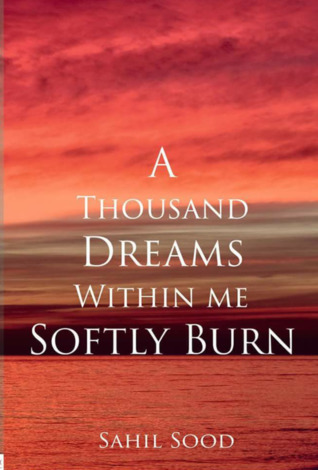Reading and viewing are essential because we know that surface notations are the cheat. It is the surface depiction of things what locks us out of the teeming, throbbing, libidinous and emotional world that we inhabit […] Literature and cinema provide a language for all the bouts of effect, anger and desire that punctuate life and escape our observation most of the times. They remind us of what a spectacle our real world is, both inside and outside.
Sahil Sood’s A Thousand Dreams Within Me Softly Burn prompts readers to ponder upon the reason for reading literature and watching films. Some works of art reflect a particular philosophy of life, which create their own reality, and reflect an intermix of emotions and desires that inhabit one’s world. Their underlying urge is to share the diverse gene pool of human experience.
The book unravels the delightful, yet thorny relationship between Saaransh and Akshay. These two young men in Chandigarh have a romantic rendezvous one late evening and begin their journey together. What is it that keeps these two men together? Whether it is love, care, lust, grief, hatred, belonging or remembrance—all these notions stem from the intrinsic need to connect with the other, perhaps with the hope of merging one’s very self into the other. Yet, despite the desire to be together, the journey of love is not that easy. Byron’s quote, “Love will find a way through paths where wolves fear to prey,” evoked in the book, reflects the strength of love and the myriad ways that love continues to drive the characters within this book.
In the book there are two narratives that unfold, along with a central essay based on the voyage through literature and cinema that evokes the voices of several writers that stir our appreciation for art. For a reader who might be uninitiated to the Thumri form of Hindustani Classical Music, or has not listened to ‘Jise Tu Qubool Kar Le’ in Devdas (1955) or Nina Simone’s ‘I Loves You Porgy,’ playing these online renditions may offer a singular experience while reading the book. The non-linear narrative adds an interesting style to the plot, making the reader peel different layers of an onion blub, seemingly muddling things up, yet seamlessly connecting each layer at its stem.
Along with the queer theme, Sahil Sood also queers the text’s structure and narrative technique, through its pictures, lyrics, letters, and essays. The suspense of a detective novel — of the mysterious ‘Dearest’ and ‘Me’ in the letters — is kept until the end. Seemingly post-structuralist in form, the text — where eight letters, sandwiched between seven chapters of Siddharth’s manuscript — might offer different readings to different readers. The personal letters included are actually poetic. Furthermore, they build on where you are in the story and give more insight into the mind of the protagonist.
Another beautiful aspect of A Thousand Dreams Within Me Softly Burn is its ability to capture the vulnerability and transcendence of the human condition. Whether it’s about Jacky, the evil dog that had a growing large patch of decaying skin, or Ami Azan, the impious lady who spent years of her life in disgrace confined to a solitary apartment, the book strikes a chord of the inner melody, waiting to find itself.
“Then one day Ami Azan stepped out at dawn. She heard a mystifying aural symphony in the air. She took out her prayer mat and started walking barefoot towards the masjid. Her hair streamed behind her as she walked leaning on a jagged wooden stick. The pewter sky smiled at her. The sound of Imam offering prayers beckoned to her. Naive birds awakened by the first light of dawn flapped their silver wings furiously. She spread her mat on the pristine floor, wrapped the hijab around her head, and with hands joined in worship started murmuring fervent prayers to Allah. Her fears metamorphosed into tears of gratitude. She held her breasts in delight. She looked at the sky and blinked with wonder. A new feeling was thus born in the history of time.”
Fiction on gay relationships in contemporary Indian writing is hard to find. It’s a subject we are uncomfortable writing about, precisely because we have mixed feelings about it. When we do chance upon such books, we are either skeptical or regard them as exceptions. This heart-moving book deals with the subject in a frank, sympathetic, and intimate style, and is likely to win over many unwilling mindsets. Sahil Sood has paved the way for a fresh outlook on the nature of gay relationships in the queer genre, which, for most, is synonymous with mushiness, longing, death and loss.
Re-published with consent of the author and Orinam, where it originally appeared.
- A Tale of Two Prides Within a Month in a City - November 14, 2019
- Book Review:‘Thousand Dreams Within Me Softly Burn’ by Sahil Sood - August 9, 2017
- Vishal Tondon : In Memoriam - July 4, 2017


